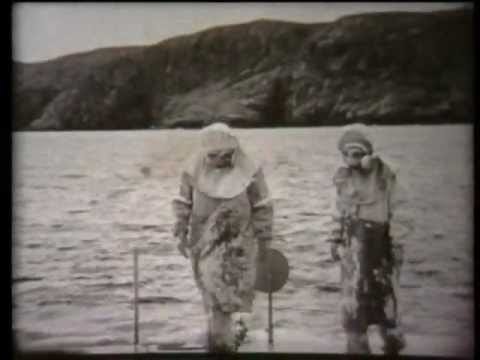“This declassified film, Operation CAULDRON 1952, contains footage which some viewers may find upsetting.
In 2008, the Ministry of Defence made it clear that the events portrayed in this 60 year old film [including the use of live animals] in no way represents current practice. This is a historical record of experimental UK Biological Warfare research procedures which were in use over 60 years ago, and should be viewed as such.
Operation CAULDRON
In 1951, proposals were made by the Microbiological Research Department, Porton Down (the UK Government's Chemical and Biological Warfare research facility) to conduct a large series of Biological Warfare (BW) experiments in the open air.
This series of BW experiments, known to Porton Down scientists as field trials, involved the release into the open air of two types of 'hot' BW agents: Brucella suis (Brucellosis) and Yersinia pestis (Plague). The entire series of BW field trials was given the codename -- Operation CAULDRON.
The site chosen for the conduct of Operation CAULDRON was located half a mile off-shore near Tulsta Head and Cellar Head on the north-east tip of the Isle of Lewis. The site seemed ideal because it appeared that in an average year there would be 28 suitable days in the months of June -- September in which field trials could take place. Permission to use this site was cleared by the Secretary of State for Scotland.
The central idea of CAULDRON was the use of a floating "island", moored in place. A "Spud Pontoon" (pier-head from "Mulberry", suitably modified) was used: essentially, this was a rectangular box, 200 ft by 60 ft, with 24 watertight compartments. Some of the compartments were flooded, so that the pontoon lay low in the water and was listed until the upwind edge was level with the water: it then presented to the wind an inclined plane, sloping gently up at not more than 1 in 10, up which the air travelled without disturbance.
An arc of test animals (guinea pigs and monkeys) and sampling points, of 25 yd radius, was established on the deck: the centre of this arc was 25 ft beyond the low edge and the source was supported here on a light floating boom. The source was either a bomb or a spray device.
Compartments, not required for flooding, were modified to hold "clean" and "dirty" animals and sampling equipment; other compartments were required for machinery used for flooding, etc.
The proposed procedure was to bring alongside, in a small boat, enough equipment and animals for 2 or 3 trials, set up for the first trial and put the rest in the "clean" room, retire to a short distance leaving men in the gas-tight compartments, and function the apparatus by radio remote control: the men on the pontoon would then rapidly change the layout and be ready for a further trial.
Laboratories, housing for "clean" and "dirty" animals, and accommodation for all CAULDRON staff were required: all these were provided by relatively simple modification of the Control ship, HMS Ben Lomond, which lay moored within a short but safe distance of the pontoon.
Before any decision could be made to undertake modification of the pontoon, the method had to be thoroughly tested. A site located at Shanklin Bay, IOW, was selected, since it was similar to the proposed site but rather more exposed to swell and therefore provided a severe test.
Flooding and listing (using improvised pumping arrangements) were found to be most satisfactorily simple and quick. Swinging the pontoon to the necessary crosswind position, also with improvised arrangements, was also easy and rapid. The behaviour of the pontoon in sea conditions as severe as would be practicable for small boat work was 'very gratifying'.
A small trial was attempted in Shanklin Bay on 23rd August, attended by Admiralty representatives. The trial was very satisfactory. It was evident that this was a 'simple and reliable technique for the conduct of trials, which could be carried out accurately and expeditiously with a remarkably small number of men'.
The first CAULDRON field trial was conducted on 26 May 1952 -- the last at the end of September 1952. Clear range duties were performed by a Royal Navy tug - HMS HENGIST. 158 civilian and service personnel were involved in Operation CAULDRON. Some 45 short-term visitors attended for 2-5 nights during the trial.
As the film shows, on at least one occasion, local dignitaries from the Isle of Lewis visited the Control ship (HMS BEN LOMOND) during the trials.
In 1953, scientists returned to The Isle of Lewis to conduct a new series of Biological Warfare field trials. These field trials, codename Operation HESPERUS, involved the open air dissemination of two types of BW agents: Brucella suis, and Francisella tularense.”



Instead of an island, today they use the whole world.
Truly evil. And they've become more ruthless, reckless and emboldened since 1952.
Hairless, soulless apes in lab coats, employed by Bill Gates, Tony Fauci and Jeremy Farrar, willingly and unthinkingly work to destroy humanity for a paycheck and pension.
Jesus wept.